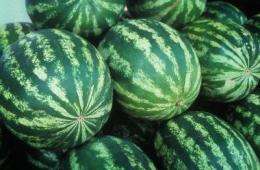Pollenizer research should help seedless watermelon farmers

Research from North Carolina State University on flower production and disease resistance in watermelon varieties should help bolster seedless watermelon harvests for farmers.
Seedless watermelons are more popular than seeded watermelons, making them a more profitable crop for farmers. But the flowers of seedless watermelon plants must be fertilized with pollen from the male flowers of seeded watermelon plants, because seedless plants do not produce genetically viable pollen.
This is a problem, because seeded watermelon plants take up space, nutrients and water that farmers would rather devote to seedless plants. Furthermore, farmers have to take steps to ensure that they don't mix up the seedless and seeded watermelons at harvest time – and find a market for those less valuable seeded watermelons.
Over the past 10 years, farmers have increasingly turned to varieties of seeded watermelons that produce pollen to fertilize the seedless plants, but that also grow very small, inedible fruit that doesn't have to be harvested and doesn't take up much space in the field. These varieties are called "pollenizers" because they are grown solely to provide pollen for the seedless watermelons.
In this study, researchers from NC State and Purdue University set out to address three questions. First, they wanted to know which pollenizer varieties produce the most male flowers, since male flowers may serve as an indicator of pollen production.
Second, at what rate does each variety produce male flowers over the course of a growing season? This is important because farmers want to time their planting so that the female flowers of seedless watermelons are blooming at the same time as the male flowers of the pollenizers.
Third, they wanted to know which pollenizers are most resistant to a fungal infection of the roots called Fusarium wilt – which can kill a plant. The more resistant a variety is to Fusarium wilt, the more likely it is that the plant will avoid becoming infected – and go on to produce plenty of pollen.
The researchers found that three varieties of pollenizers produced the most male flowers over the course of a season: 'SP-1,' 'Sidekick' and '5WDL 6146.' Two– 'Sidekick' and '5WDL 6146' – also showed relatively low rates of infection when exposed to Fusarium.
The study found that several other varieties were even more resistant to Fusarium wilt, including 'Ace' and 'Pinnacle'– but they produced fewer male flowers.
"All in all, this should help farmers make informed decisions about which pollenizers to plant with their seedless watermelons," says Dr. Chris Gunter, assistant professor of horticultural science at NC State and lead author of the paper. "A lot depends on the conditions in their fields, such as whether the fields have a history of Fusarium wilt."
More information: The paper, "Staminate Flower Production and Fusarium Wilt Reaction of Diploid Cultivars used as Pollenizers for Triploid Watermelon," was co-authored by Dr. Daniel Egel of Purdue and is published in the October issue of HortTechnology.
Provided by North Carolina State University















